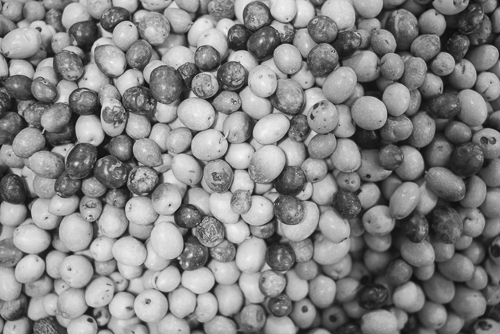The Rubiu oil mill was founded in the 1950s by the father of the present owner, Nicoletta Rubiu. Already from the foundation, this oil mill used the the best available machinery making it the centre of olive oil production in the region of Sulcis-Iglisiente. The lowlands on which this oil mill is located are surrounded by gently, rolling hills and is ideal for growing olive trees and vines. Various olive cultivars are used in the production of olive oil, with Bosana the most commonly used. Another cultivar called “tonda di Cagliari” or “nera di Gonnos” is also grown together with “Pizz’ e Carroga” which are put whole in brine.
Having entered the oil mill, we also enter an atmosphere filled with a slightly bitter fragrance of olives which have been crushed and where small groups of women and men are waiting patiently for their olives to be turned into olive oil, chatting amicably, but impossible to perceive anything because of the noisy machinery. It’s the same atmosphere and the same sensations like in the past although we don’t any longer find the imposing granite millstone, which has been conserved with the care deserved for a historic monument. The bull, which made the millstone turn around while the olives were crushed, is gone. Likewise, all the locals who came to watch the yellow olive oil flowing out of the mill. However, Mediterranean fragrances are still produced like in the past, while only the owners of the olives are watching contentedly all the phases the olives have to pass through in order to be turned into the golden liquid, which serves as an indispensable ingredient for any dish on their tables from toasted bread topped with olive oil and chopped tomatoes to various salads, from sauces to stews.
The olives from each owner are first placed in square boxes waiting to be placed in a flippable trolley. Having filled the trolley with olives, it is flipped such that all the olives fall into a container with a funnel at its base. When the time is right, the funnel is opened such that the olives fall down on a conveyor belt with parallel tracks which prevent the olives from falling down. Instead, the conveyor belt brings them upwards until they fall down into a machine, which removes foreign bodies like leaves and branches, which inevitably follow the olives from the harvest. Then, the olives are cleaned by means of running water in order to remove any remaining impurities before entering the olive-press where they are crushed, turning them into a mix of oily and fragrant mush together with hard fragments from the stones inside the olives. This mix is transferred to adjacent containers where rotating blades make it more uniform before it enters a centrifuge where solid and liquid parts are separated. The wooden residues from the stones, which are heavier than the liquid parts, are expelled. The liquid parts, consisting of water and oil are separated because they have different densities. After having filtered the oil, it is collected in a container, ready to be bottled and brought home by the owners. The wooden residues from the stones can be used in various ways like feed for pigs or poultry or compost for enriching soil. Alternatively, they may be separated and turned into pellets for heating.

